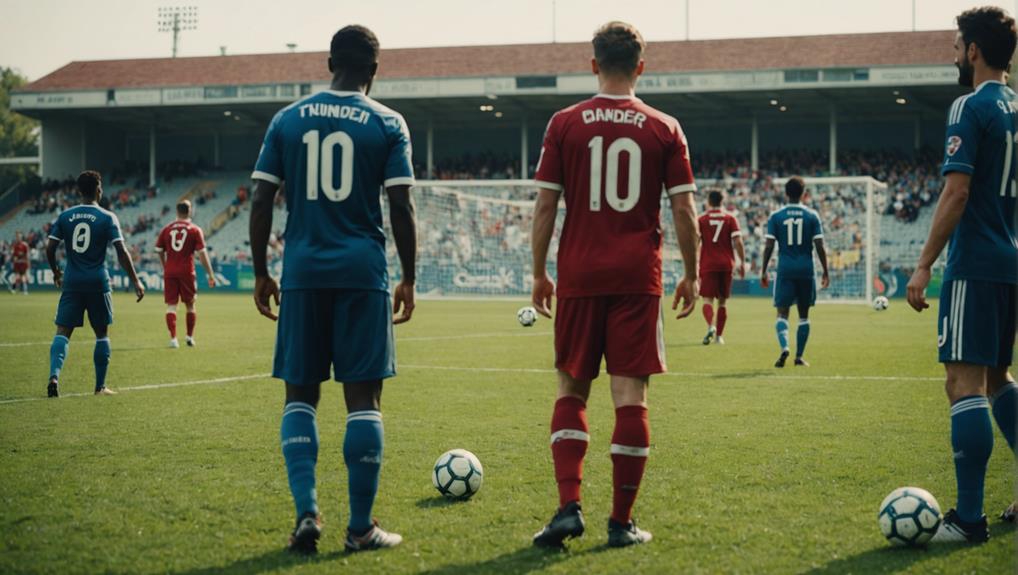
Understanding the Basics of Soccer Positions
July 28, 2024To understand soccer positions, focus on key roles like goalkeepers who stop goals, fullbacks supporting defense, center backs protecting the line, midfielders shielding, and strikers scoring. Goalies need quick reflexes and good kicking, while fullbacks must defend well and join attacks. Center backs organize defenses, and midfielders like N'Golo Kanté intercept and tackle. Midfielders with strong passing are essential, and strikers like Ronaldo and Messi excel at scoring. Exploring these positions will give you a solid grasp of soccer's dynamics and teamwork intricacies in the game.
Goalkeeper
As a goalkeeper in soccer, you play an essential role as the last line of defense against the opposing team's goal-scoring attempts. Your primary objective is to prevent the other team from scoring goals by utilizing your hands within the penalty area. Quick reflexes are essential for reacting swiftly to shots on goal, showcasing your agility in making critical saves. Additionally, your kicking abilities and footwork are important for distributing the ball effectively to your teammates and initiating counterattacks.
One of the legendary goalkeepers who revolutionized the position is Lev Yashin. Known as the 'Black Spider,' Yashin's incredible shot-stopping abilities and commanding presence inspired generations of goalkeepers worldwide. By studying the techniques and innovations of iconic figures like Yashin, you can continue to hone your skills and make a significant impact as the guardian of your team's goal.
Right Fullback
As a right fullback, your defensive role responsibilities are essential in supporting your team's backline and thwarting opponent attacks on the left side.
You must seamlessly overlap with your right midfielders to create attacking opportunities and provide width to your team's play.
Effective communication with your teammates is key to guarantee cohesive defensive and offensive strategies on the right flank.
Defensive Role Responsibilities
The defensive role responsibilities of a right fullback in soccer involve supporting right-wingers in attack and defending against left-sided opponent attacks. As a right fullback, you're expected to execute overlapping runs with the right-winger, providing width in attack while maintaining the ability to track back swiftly to cover defensive duties.
Possessing strong positional awareness is vital for a right fullback, as it allows you to anticipate and react effectively to both offensive and defensive situations. Your defensive responsibilities extend beyond individual battles, as you play a key role in ensuring defensive stability on the right flank.
To excel in this position, you must be a versatile player capable of seamlessly switching between offensive and defensive roles. Your contributions as a right fullback aren't limited to defense; you're also tasked with offering right-wing support and delivering accurate crosses into the box.
Embracing the demands of this position means acting as a linchpin between the defense and midfield, facilitating changes and maintaining balance within the team.
Overlapping With Midfield
To effectively overlap with the midfield as a right fullback in soccer, you must seamlessly integrate offensive support with defensive duties. As a Right Fullback, your role is vital in creating scoring opportunities while also being ready to defend against left-sided opponent attacks.
Balancing offensive and defensive responsibilities requires not only speed and stamina but also the ability to make quick decisions during shifts. Your positioning on the field plays a significant role in supporting right-wingers during attacking plays and aiding in defensive strategies.
Being a Right Fullback means you're essential in both defensive and offensive phases of the game. Understanding when to move up to support the midfield and when to drop back to defend is key. Your speed will help you overlap effectively with the midfield, while your quick decisions will determine the success of your team's transformations.
Embrace the challenge of balancing these roles to become a versatile and impactful player in the team.
Communication With Teammates
Effectively coordinating with your teammates as a Right Fullback involves clear and timely communication to guarantee defensive solidity and offensive fluidity. Communication is key in coordinating defensive strategies, marking assignments, and overlapping runs with midfielders. By providing verbal cues, you establish seamless shifts between defense and offense, enhancing team cohesion.
Signal for support from midfielders and wingers to maintain defensive shape and create counter-attacking opportunities. Your role in organizing defensive lines, marking set-pieces, and managing opposition threats is vital, requiring clear communication with the goalkeeper. Through effective communication, you can cover attacking opponents, make defensive adjustments, and contribute to the team's overall success.
Left Fullback
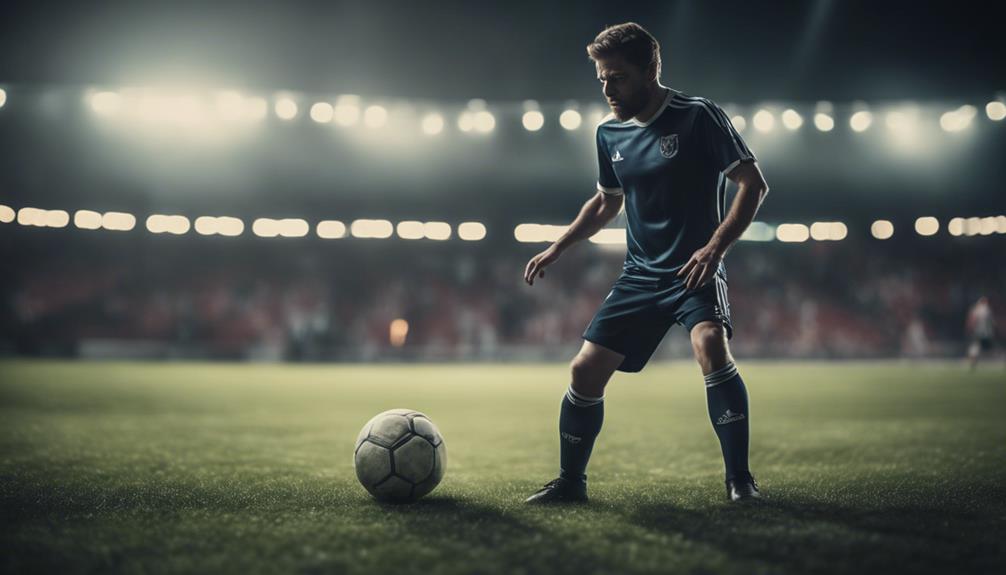
As a left fullback, your primary role is to provide defensive support to the left winger and thwart right-side attacks effectively. To excel in this position, you must maintain excellent positional awareness, utilize your speed to intercept plays, and execute precise tackles when needed.
Effective communication with your teammates, especially the left midfielder, is key to coordinating overlapping runs and contributing to attacking plays in the final third.
Defensive Role Description
In soccer, the Left Fullback plays an essential defensive role by supporting left-wingers and fending off attacks from the right side. Left Fullbacks need to possess strong defensive skills, exhibit good positioning, and be ready to provide offensive support when required. They're pivotal in maintaining the team's defensive shape and facilitating the shift of the ball from defense to midfield.
Left Fullbacks are recognized for their stamina, speed, and capability to deliver accurate crosses into the opponent's box during attacking plays. Notable players like Roberto Carlos and Ashley Cole have excelled in the Left Fullback position, highlighting the significance of this defensive role in soccer.
Mastering the art of defending against opposing attacks while supporting the team's offensive endeavors makes the Left Fullback a critical player on the field.
Tactical Positioning Tips
To excel in your role as a Left Fullback, mastering tactical positioning is key to effectively defending against right-sided attacks and supporting the left winger. Here are some tactical positioning tips to enhance your performance:
- Focus on your defensive skills to stop opponents and maintain a solid defensive structure.
- Engage in overlapping runs with the left winger to create numerical advantages in attack.
- Provide quality crosses into the box to help your team score goals and create scoring opportunities.
- Maintain balance on the left side of the field by knowing when to support the attack and when to prioritize defensive duties.
Communication With Teammates
Effective communication skills are essential for the Left Fullback to coordinate with teammates and maintain a strong defensive line. The Left Fullback plays an important role in communicating with the left winger to strategize both defensively and offensively.
Clear communication with teammates is crucial for the Left Fullback to receive support when facing attacking opponents and to organize defensive formations effectively. By effectively communicating with other defenders, the Left Fullback guarantees a cohesive defensive line that can withstand pressure from the opposing team.
Additionally, the Left Fullback's communication skills are pivotal in making quick decisions and coordinating with the team during fast-paced game situations. Through constant communication and coordination with teammates, the Left Fullback can contribute significantly to the team's overall performance by executing defensive strategies, supporting the left winger, and maintaining a solid defensive line.
Center Back
Positioned at the heart of the defense line, center backs play an important role in protecting their team's goal. These defensive players are tasked with significant responsibilities to guarantee the team's defensive solidity:
- Marking Opponents: Center backs must closely mark opposing players to prevent them from having clear goal-scoring opportunities.
- Intercepting Passes: They need to anticipate passes and interceptions to regain possession for their team.
- Clearing the Ball: Center backs are responsible for clearing dangerous balls out of the defensive zone to maintain security.
- Prevent Scoring Opportunities: Their primary goal is to deny the opposition any chances to score by maintaining a strong defensive line.
To excel in this position, center backs require physical strength, communication skills, and tactical awareness.
Renowned players like Franz Beckenbauer and Sergio Ramos have exemplified the qualities needed to be successful center backs. Their contributions are essential in providing stability and structure to the team's defensive setup.
Defending Midfielder
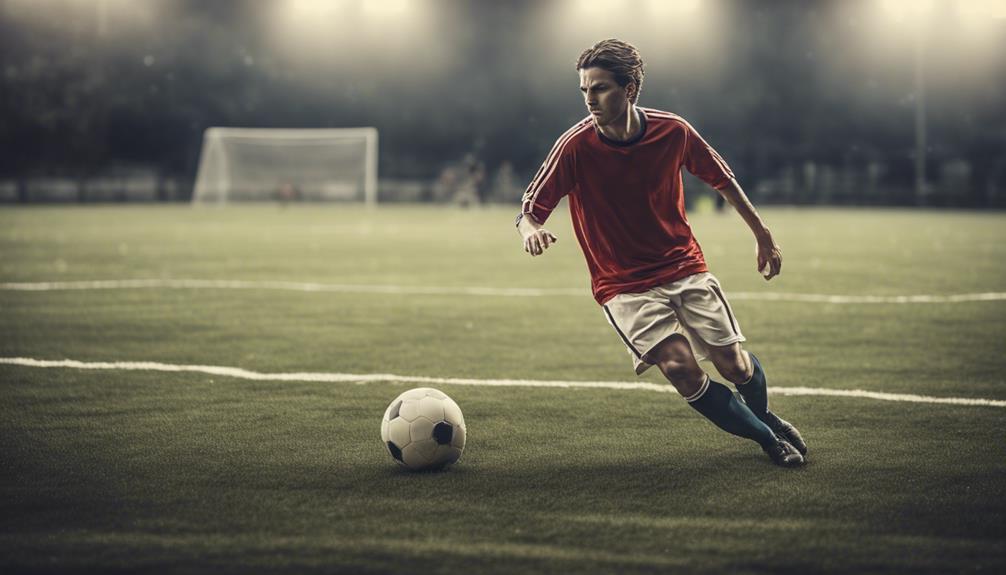
Center backs rely on defending midfielders to provide a shield in front of the defense, breaking up opponent attacks and disrupting their rhythm. The defensive midfielder, a pivotal position in soccer, excels in interceptions, tackling, and possession to initiate counterattacks.
With a strong physical presence, these players are known for their tough tackling and disruptive style of play, making it difficult for opponents to establish their offensive flow. N'Golo Kanté, Fabinho, and Sergio Busquets are prime examples of top-tier defending midfielders, recognized for their defensive prowess and exceptional ball-winning abilities on the field.
Their ability to read the game, make crucial tackles, and regain possession quickly is instrumental in providing defensive stability and facilitating the team from defense to attack seamlessly. As a defending midfielder, your role is vital in thwarting opponent threats and setting the tempo for your team's play.
Right Midfielder
Playing on the right side of the midfield, the right midfielder in soccer contributes to the team's attack and provides defensive support. Right midfielders play a vital role in providing width to the team's play and play a significant role in creating goal-scoring opportunities.
Some key aspects of the right midfielder position include:
- Attacking Role: Right midfielders are responsible for delivering accurate crosses into the opponent's penalty area, creating chances for their teammates to score.
- Speed and Dribbling Skills: They rely on their speed and dribbling abilities to beat opponents on the flank and move the ball up the field effectively.
- Tracking Back: Despite their attacking duties, right midfielders must also track back and support the defense, showcasing their defensive work rate.
- Jersey Numbers: Right midfielders commonly wear numbers like 7 or 11, symbolizing their attacking nature on the right side of the pitch.
These players, like David Beckham or Mohamed Salah, exemplify the importance of the right midfielder in modern soccer.
Central Midfielder
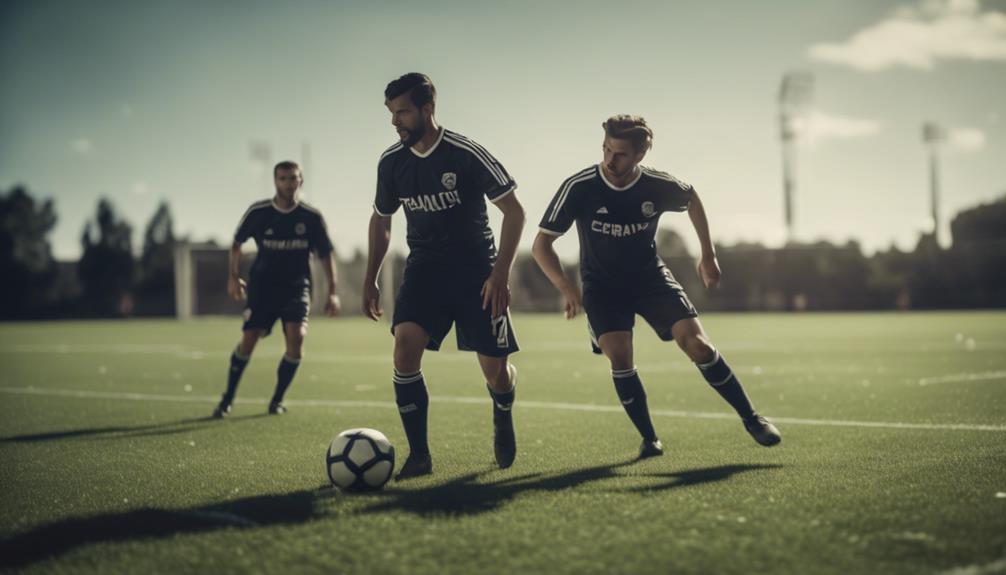
In the heart of the midfield, central midfielders act as the linchpin connecting defensive solidity to attacking creativity. Known as pivot players, they play an essential role in controlling the flow of the game. Central midfielders must possess exceptional passing, vision, and decision-making abilities to dictate play effectively.
Their responsibilities include maintaining possession, distributing the ball efficiently, and breaking up opponent attacks. These players provide important defensive cover, initiate attacking moves, and support both ends of the field.
Central midfielders are the engine room of the team, influencing the game with their intelligence and skill on the ball. Their ability to read the game, make quick decisions, and orchestrate play makes them indispensable. Whether intercepting passes, launching attacks, or supporting the defense, central midfielders are versatile assets on the field.
Their impact extends beyond individual moments, as they're instrumental in shaping the team's overall strategy and success.
Striker
Central midfielders are the linchpin connecting defensive solidity to attacking creativity, while strikers are the key offensive players responsible for scoring goals. Strikers hold an essential role in the team, with their goal-scoring instincts and shooting accuracy being crucial to securing victories.
They work in tandem with midfielders to create scoring opportunities and capitalize on them efficiently. When you watch a match, pay attention to the players wearing jersey numbers like 9 or 11; these are often the strikers who carry the responsibility of being the primary goal-scorer for the team.
Famous strikers such as Cristiano Ronaldo, Lionel Messi, and Robert Lewandowski exemplify the skill and finesse required in this demanding position. To excel as a striker, hone your shooting skills, anticipate plays, and have the confidence to be a goal-scoring threat whenever on the field.
Attacking Midfielder
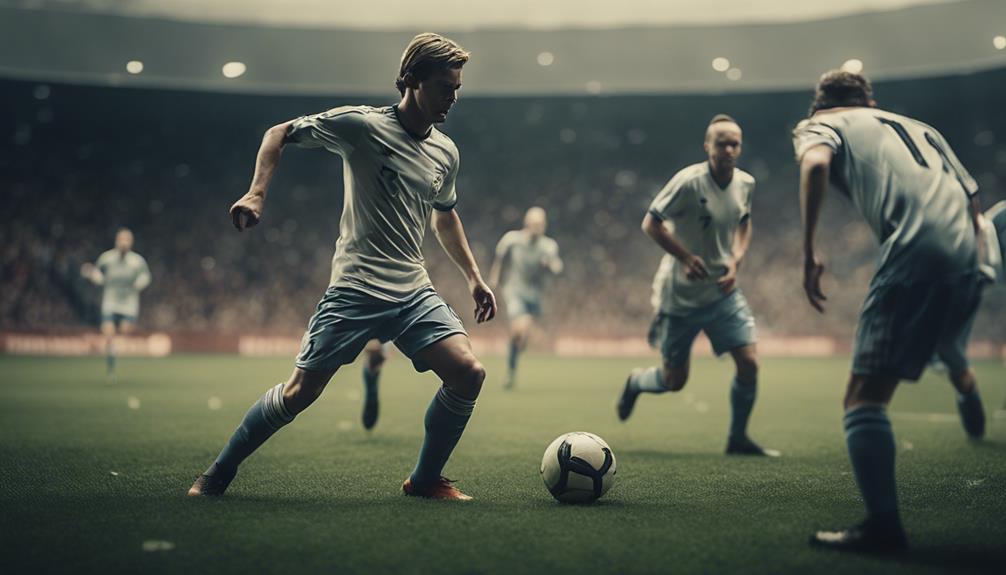
The Attacking Midfielder's role as a playmaker is pivotal in creating scoring opportunities and connecting the midfield with the attack. As an attacking midfielder, your primary focus is on vision, creativity, and executing precise passes to set up goal-scoring chances for your team.
Wearing the coveted jersey number 10, you're expected to be the focal point of the team's offensive plays, often providing essential assists to the strikers. Players like Diego Maradona, Lionel Messi, and Ronaldinho have exemplified the art of being attacking midfielders, showcasing not only their playmaking abilities but also their knack for finding the back of the net.
Your role demands exceptional spatial awareness to exploit gaps in the opponent's defense and create opportunities for your team. With your technique and dribbling skills, you orchestrate the team's attacking strategies, making decisive contributions in both scoring and assisting.
Embrace your role as an attacking midfielder, as you hold the key to opening up the opponent's defense and leading your team to victory.
Conclusion
So there you have it – the puzzle pieces of soccer positions fitting together like a perfectly orchestrated symphony.
Each player has a specific role to play, working together to create a masterpiece on the field.
From the indispensable goalkeeper guarding the net to the cunning striker scoring goals, every position plays a crucial part in the beautiful game of soccer.
Embrace the diversity of roles and watch the magic unfold on the pitch.


